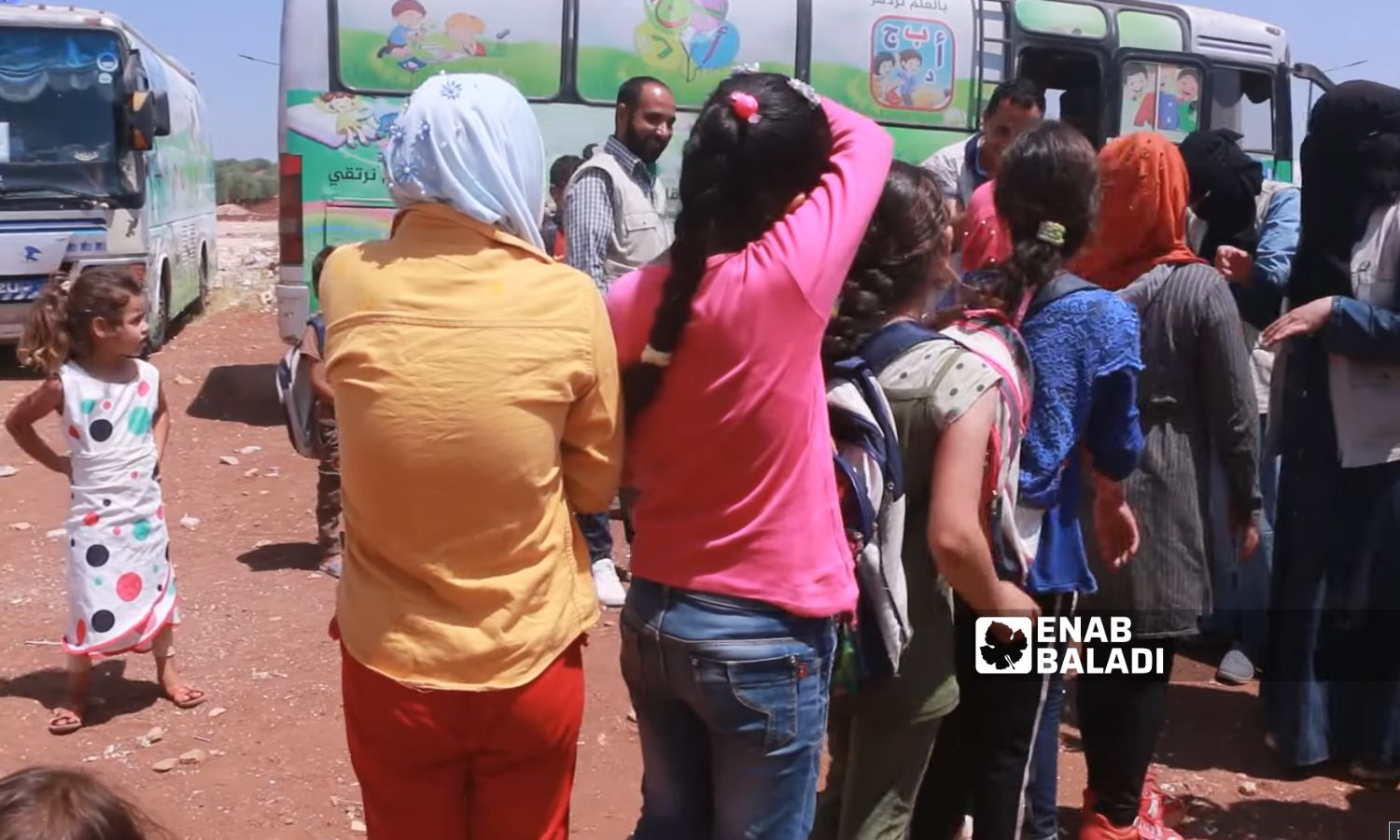



Enab Baladi – Aleppo countryside
A bus equipped with the necessary foundations to provide an educational process moves to Jindires, northern Syria, targeting the students of the city whose schools were destroyed by the devastating Feb.6 earthquake, which affected large areas, northwestern Syria and southern Turkey.
Orange Organization launched the mobile educational units at the beginning of April, and they operate in 37 educational centers and points concentrated in the city of Jindires and its environs.
They are reached in cooperation and coordination with the Education Directorate in the region, according to what the Education Officer at Orange, Mohamad al-Shihab, said.
Al-Shihab added to Enab Baladi that the mobile educational units have begun to provide educational interventions through trained teams of teachers and supportive facilitators through two mechanisms.
The first is through buses that move between several points daily, in which educational lessons and psychosocial support activities are provided.
These activities aim to ensure that children return to the daily routine by continuing their learning and catching up on the past days.
At the same time, they are provided with supportive activities that bring them back to a state of psychological stability after they were exposed to a difficult psychological state as a result of the loss of many people and being affected by the scenes of the destruction of their homes and schools, according to al-Shihab.
As for the second mechanism, it is through a mobile teacher and facilitator of psychological support activities who move between areas that buses cannot easily reach and where educational services are not available close to shelter centers and gatherings of people affected by the earthquake.
The project targets children from six to 12 years old, both male and female. More than 3,100 children will benefit from the project, who have been provided with bags and tools for psychological support activities, according to the organization’s education officer.
Among the advantages of the project is the possibility of starting lessons directly without the need for large logistical equipment or infrastructure, following up the movement of displacement, providing children with the skills and knowledge necessary to continue the educational process, and the possibility of integrating them with their peers if schools are available near them.
Al-Shihab believes that parents are satisfied with the awareness activities that contributed to modifying children’s behavior and their interaction with their surrounding community, as over time, the mobile units became a source of “psychological safety and a child-friendly learning space.”
The new learning environment on buses for children was accompanied by a fear that it would not be a suitable place for education, and the same applies to teachers because of its difference from classrooms in schools, according to the Education Officer at Orange.
The plan of visits and activities required continuous and field follow-up, with the need for updates regarding children’s educational needs.
Bilal Sabsabi, a teacher on an educational bus, confirmed to Enab Baladi that it was difficult to teach on buses at first, but with the passage of days, the process was crowned with success, as he put it, based on the gradual increase in the number of students, and the parents’ satisfaction with the completion of their children’s educational journey.
Within the mobile units project, teachers provide meaningful educational and recreational activities for children, but the difficulties they face are represented by the increase in the number of students in these units and the need for more buses in order to accommodate these numbers, Sabsabi said.
The head of the local council in the city of Jindires, Mahmoud Haffar, told Enab Baladi that the schools in the city have generally returned to work.
However, the problem is the large number of camps surrounding the city, which has made it difficult for children to travel from the camps to schools.
The mobile buses within the camps contributed to solving the problem of these students, and there is a plan to establish ten educational centers within the camps, Haffar said.
During the second educational semester after the earthquake, the teachers focused on repeating the subjects of the first semester, and on implementing recreational activities for children, according to Hafar, who indicated that the current support is not sufficient to avert the crisis, describing the educational situation in the city as “average.”
According to the United Nations Children’s Fund (UNICEF), More than four months after the earthquake occurred, 3.7 million children in Syria are still “facing miserable conditions and in need of humanitarian assistance.”
In its statement issued last May, the organization stated that “nearly 1.9 million children have had their education disrupted, and many schools are still being used as shelters.”
The Un Office for the Coordination of Humanitarian Affairs (OCHA) said in May that “no less than 452 primary and secondary schools” have been damaged to varying degrees in northwestern Syria.
More than one million school-age children need educational support and are at risk of dropping out of school, according to the report, and no fewer than 25,000 teachers also need assistance, including “mental health and psychosocial support.”
The Qeeam/Values Foundation launched a similar educational project in July 2019, which is a mobile bus that attracts children in the city of al-Bab, in the eastern countryside of Aleppo, and contains the necessary tools for education.
Enab Baladi’s correspondent in Aleppo countryside, Dayan Junpaz, contributed to this report.
if you think the article contain wrong information or you have additional details Send Correction